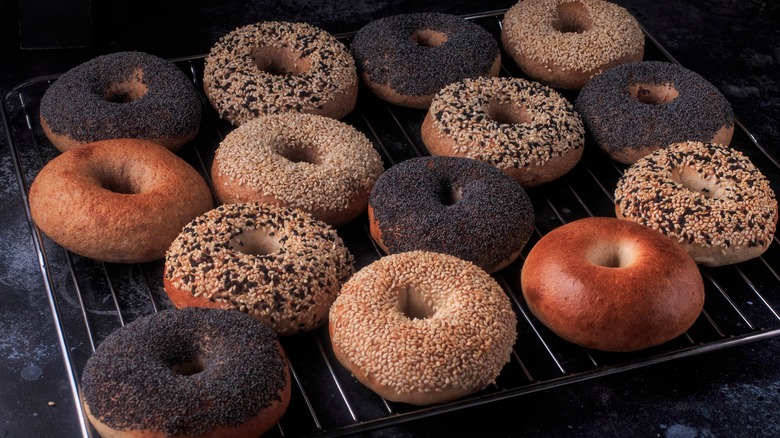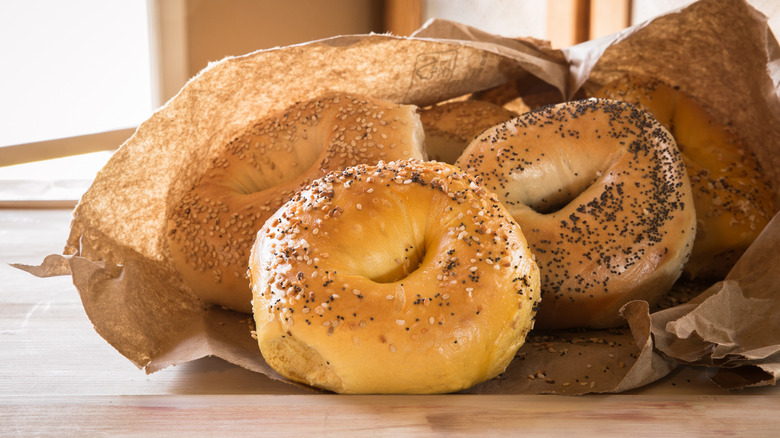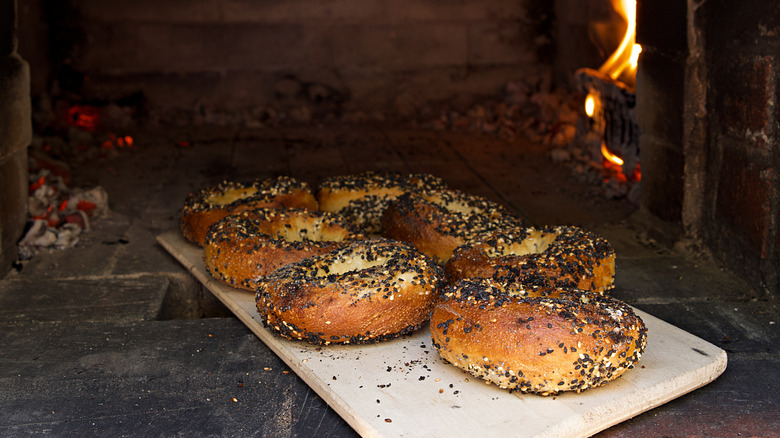New York-Style Bagels Vs. Montreal: What's The Difference?
Is there anything better than a cream cheese bagel in the morning? Well, though some of you readers might say, "Yes, of course, there is!" Many people up the Atlantic Coast of the US and Canada might heartily disagree. Both Montreal and New York are famously obsessed with bagels with their golden skins and soft centers (via USA Today). But despite the East Coast's seeming ownership of the bagel, both cities adopted their variations from Old World immigrants.
The Atlantic lays out the history of bagels that brings us back about six centuries. There is no set certainty to the origin story of the bagel, no one moment where historians are sure that it was invented. Instead, there are a handful of stories. One tale begins with soft German pretzels, which were transformed into a circle shape and called an obwarzanek as early as the 14th century. Another bagel origin story involves Queen Jadwiga of Poland, who ate obwarzanek for lent. Yet another story takes place in Austria, where a baker shaped his dough into the shape of a stirrup which in the German language would be called a "beugel."
No matter the origin, it is clear to Smithsonian Magazine that Eastern European immigrants are what brought the basics of bagel making, with all its shaping, boiling, and baking, to North America. And on these New World shores, regional recipes began to appear, some of the most distinct being the New York and the Montreal style bagels.
The New York-style bagel
New Yorkers love their bagels and are proud of their distinct crunchy and soft texture. The New York bagel is known for having a shiny, glaze-like crust with a chewy white center that tastes a little savory. The New York Times claims that the first bagels appeared in New York City in the hands of Jewish immigrants around the turn of the 19th century. Back then, bagels were smaller and tougher than they are today.
Reader's Digest writes that the modern New York bagels have their unique texture thanks to the state's "soft water." The difference between hard and soft water goes to show how the smallest differences make the biggest of changes when it comes to baking. New York's tap water has a low concentration of minerals, which means that the yeast in the bread will ferment slower, and the gluten will activate with less strength, baking that inner dough extra soft (via Bake). Reader's Digest also points out the layered cooking method for New York bagels, boiling them to lock the moisture inside the dough and then baking them off to achieve that classic crispy crust.
The Montreal bagel
Like New York, Montreal's bagels were brought to the Canadian city by Jewish immigrants from Poland and other Eastern Europeans. According to Montreal, the question of who brought the bagel to Montreal is somewhat controversial. Chaime Seligman is cited in 1900 as the father of the Montreal bagel; however, some believe that Isadore Shlafman and Jacob Drapkin were the first to introduce it in 1932. Reports conflict, and like with much of history, there isn't one definitive answer of how the bagel came to be.
The similarities between the New York and Montreal bagels begin with their shape and end with their pre-boil. Like most bagels, the Montreal bagel is donut-shaped, but otherwise, this bread is truly unique. The Bagel Time reports that what makes the Montreal bagel unique is that it is always handmade and cooked in a wood-fired oven. Yep, this bagel is always hot and fresh. Another difference between the Montreal and the New York bagel is that the Montreal's dough is much denser and sweeter. This sweetness is compounded when the bagel is boiled in honey water and crusted with poppy or sesame seeds to give it an extra crunch.


